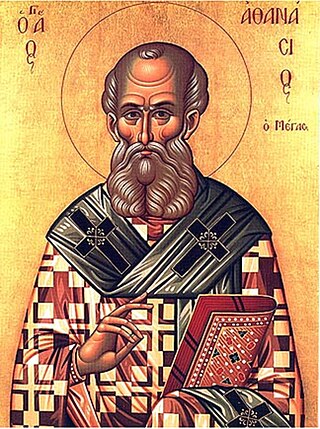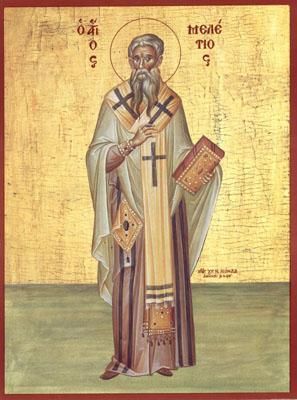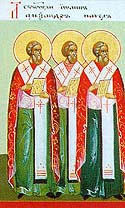Related Research Articles
Arianism is a Christological doctrine considered heretical by all modern mainstream branches of Christianity. It is first attributed to Arius, a Christian presbyter who preached and studied in Alexandria, Egypt. Arian theology holds that Jesus Christ is the Son of God, who was begotten by God the Father with the difference that the Son of God did not always exist but was begotten/made before time by God the Father; therefore, Jesus was not coeternal with God the Father, but nonetheless Jesus began to exist outside time.

Athanasius I of Alexandria, also called Athanasius the Great, Athanasius the Confessor, or, among Coptic Christians, Athanasius the Apostolic, was a Christian theologian and the 20th pope of Alexandria. His intermittent episcopacy spanned 45 years, of which over 17 encompassed five exiles, when he was replaced on the order of four different Roman emperors. Athanasius was a Church Father, the chief proponent of Trinitarianism against Arianism, and a noted Egyptian Christian leader of the fourth century.
Eusebius of Nicomedia was an Arian priest who baptized Constantine the Great on his deathbed in 337. A fifth-century legend evolved that Pope Sylvester I was the one to baptize Constantine, but this is dismissed by scholars as a forgery 'to amend the historical memory of the Arian baptism that the emperor received at the end of his life, and instead to attribute an unequivocally orthodox baptism to him.' He was a bishop of Berytus in Phoenicia. He was later made the bishop of Nicomedia, where the Imperial court resided. He lived finally in Constantinople from 338 up to his death.

The First Council of Nicaea was a council of Christian bishops convened in the Bithynian city of Nicaea by the Roman Emperor Constantine I. The Council of Nicaea met from May until the end of July 325.

Saint Meletius was a Christian bishop of Antioch from 360 until his death in 381. However, his episcopate was dominated by a schism, usually called the Meletian schism.

Alexander of Constantinople was bishop of Byzantium from 314 and the first bishop of Constantinople from 330. Scholars consider most of the available information on Alexander to be legendary.

Arius was a Cyrenaic presbyter and ascetic. He has been traditionally regarded as the founder of Arianism, which holds that Jesus Christ was not coeternal with God the Father, but was rather created before time. Arian theology and its doctrine regarding the nature of the Godhead held in common a belief in subordinationism with most Christian theologians of the 3rd century, with the notable exception of Athanasius of Alexandria.

Eustathius of Antioch, sometimes surnamed the Great, was a Christian bishop and archbishop of Antioch in the 4th century. His feast day in the Eastern Orthodox Church is February 21.

Hosius of Corduba, also known as Osius or Ossius, was a bishop of Corduba and an important and prominent advocate for Homoousion Christianity in the Arian controversy that divided the early Christianity.
In 294 AD, Sirmium was proclaimed one of four capitals of the Roman Empire. The Councils of Sirmium were the five episcopal councils held in Sirmium in 347, 351, 357, 358 and finally in 375 or 378. In the traditional account of the Arian Controversy, the Western Church always defended the Nicene Creed. However, at the third council in 357—the most important of these councils—the Western bishops of the Christian church produced an 'Arian' Creed, known as the Second Sirmian Creed. At least two of the other councils also dealt primarily with the Arian controversy. All of these councils were held under the rule of Constantius II, who was eager to unite the church within the framework of the Eusebian Homoianism that was so influential in the east.
Marcellus of Ancyra was a Bishop of Ancyra and one of the bishops present at the Council of Ancyra and the First Council of Nicaea. He was a strong opponent of Arianism, but was accused of adopting the opposite extreme of modified Sabellianism. He was condemned by a council of his enemies and expelled from his see, though he was able to return there to live quietly with a small congregation in the last years of his life. He is also said to have destroyed the temple of Zeus Belos at Apamea.
The Council of Seleucia was an early Christian church synod at Seleucia Isauria.
Homoousion is a Christian theological term, most notably used in the Nicene Creed for describing Jesus as "same in being" or "same in essence" with God the Father.
The Council of Serdica, or Synod of Serdica, was a synod convened in 343 at Serdica in the civil diocese of Dacia, by Emperors Constans I, Augustus in the West, and Constantius II, Augustus in the East. It attempted to resolve "the tension between East and West in the Church." “The council was a disaster: the two sides, one from the west and the other from the east, never met as one.”
The fourth-century Arian controversy was a series of Christian disputes about the nature of Jesus Christ.
“The crisis of the fourth century was the most dramatic internal struggle the Christian Church had so far experienced”.
The Pneumatomachi, also known as Macedonians or Semi-Arians in Constantinople and the Tropici in Alexandria, were an anti-Nicene Creed sect which flourished in the regions adjacent to the Hellespont during the latter half of the fourth, and the beginning of the fifth centuries. They denied the godhood of the Holy Ghost, hence the Greek name Pneumatomachi or 'Combators against the Spirit'.
In the history of Christianity, the first seven ecumenical councils include the following: the First Council of Nicaea in 325, the First Council of Constantinople in 381, the Council of Ephesus in 431, the Council of Chalcedon in 451, the Second Council of Constantinople in 553, the Third Council of Constantinople from 680 to 681 and finally, the Second Council of Nicaea in 787. All of the seven councils were convened in what is now the country of Turkey.
Ursacius was the bishop of Singidunum, during the middle of the 4th century. He played an important role during the evolving controversies surrounding the legacies of the Council of Nicaea and the theologian Arius, acting frequently in concert with his fellow bishops of the Diocese of Pannonia, Germinius of Sirmium and Valens of Mursa. Found at various times during their episcopal careers staking positions on both sides of the developing theological debate and internal Church politicking, Ursacius and his fellows were seen to vacillate according to the political winds.
Cecropius of Nicomedia was a bishop of Nicomedia and a key player in the Arian controversy.
Theodotus was the bishop of Laodicea in Syria from the early 300s. He replaced Stephen, who apostasized during the Great Persecution (303–313). The exact year of his consecration cannot be fixed more precisely. He attended at least four church councils.
References
- Westminster Dictionary of Church History, ed. Jerald C. Brauer (Philadelphia: Westminster Press, 1971)
Notes
- ↑ "CATHOLIC ENCYCLOPEDIA: Tyre". www.newadvent.org. Retrieved 2024-10-25.
- 1 2 3 4 5 6 7 Anatolios, Khaled (2004). Athanasius. Psychology Press. p. 13. ISBN 978-0-415-20202-2.
- ↑ "The Early Unitarians: Arius and His Followers". people.wku.edu. Retrieved 2024-10-25.
- ↑ Thran, Matthew (2010-10-01). "Arius: A Classical Alexandrian Theologian". Honors Projects.
- ↑ Labuchli, Samuel (1959-06-01). "The Case of Athanasius Against Arius". Concordia Theological Monthly. 30 (1).
- ↑ Reeves, Ryan (2016-05-09). "Who was Athanasius and Why Was He Important?". The Gospel Coalition. Retrieved 2024-10-25.
- ↑ "Saint Athanasius | Biography & Facts | Britannica". www.britannica.com. Retrieved 2024-10-25.
- ↑ "Reading Guide 2: Week II: Athanasios of Alexandria, Life St. Antony; Salvian of Marseilles, On the Judgment of God; Palladius, The Lausiac History (On Melania the Elder)". web.pdx.edu. Retrieved 2024-10-25.
- ↑ "Arius and Nicea". Fuller Seminary.
- ↑ "Jesus Christ God, Man and Savior Week Six: God the Son at Nicaea and Constantinople: The Problem with Modalism/Sabellianism: The Rise of Arianism". Jesus Christ God, Man and Savior Week Six: God the Son at Nicaea and Constantinople. Retrieved 2024-10-25.
- ↑ "Jacques Maritain Center: GC 4.6a". www3.nd.edu. Retrieved 2024-10-25.
- 1 2 3 Davis, Jack (2017-12-01). "The Importance of Athanasius and the Views of His Character". Doctoral Dissertations and Projects.
- ↑ Osequeda, Jason. Because it is New Rome: The Authority of the Patriarchate of Constantinople, 379-553 (Thesis). University of Chicago. doi:10.6082/m15h7df0. page 165
- ↑ "Eusebius of Caesarea". www.ccel.org. Retrieved 2024-10-25.
- ↑ Socrates Scholasticus, "The Eccesiastical History, by Socrates Scholasticus," in Socrates, Sozomenus: Church Histories, ed. Philip Schaff and Henry Wace, trans. A. C. Zenos, vol. 2, A Select Library of the Nicene and Post-Nicene Fathers of the Christian Church, Second Series (New York: Christian Literature Company, 1890), p.30.
- ↑ Philip Schaff and David Schley Schaff, History of the Christian Church, vol. 3 (New York: Charles Scribner’s Sons, 1910), p.874.
- ↑ "Jordan: Major Christian Heresies". pages.ucsd.edu. Retrieved 2024-10-25.
![]() This article incorporates text from a publication now in the public domain : Herbermann, Charles, ed. (1913). "Tyre". Catholic Encyclopedia . New York: Robert Appleton Company.
This article incorporates text from a publication now in the public domain : Herbermann, Charles, ed. (1913). "Tyre". Catholic Encyclopedia . New York: Robert Appleton Company.